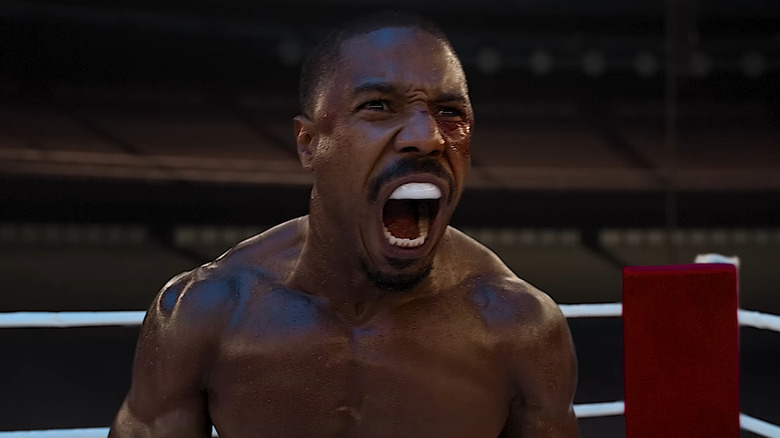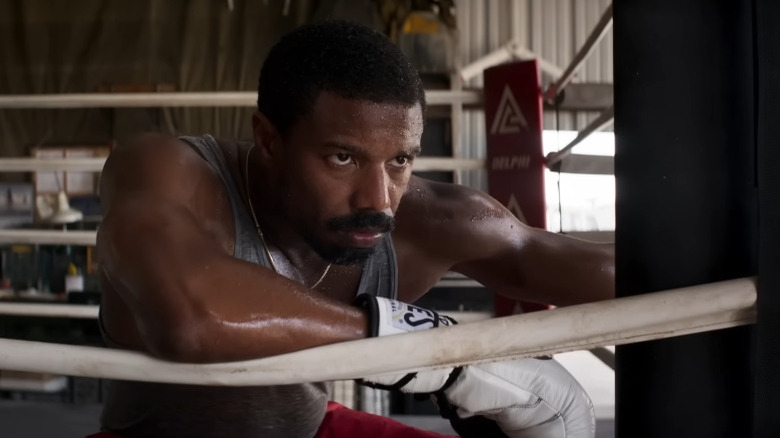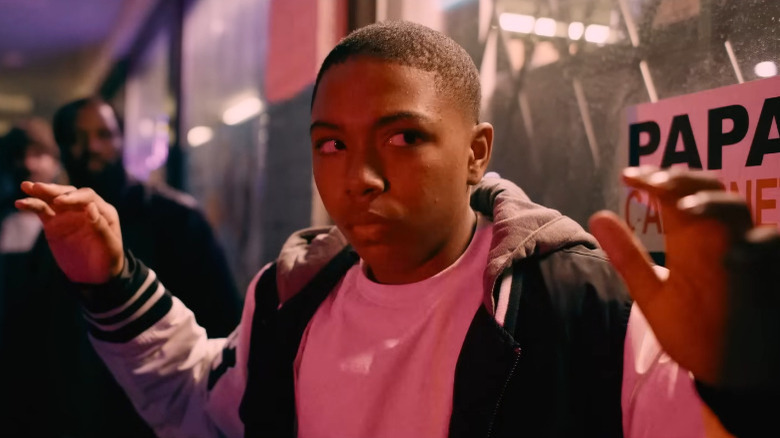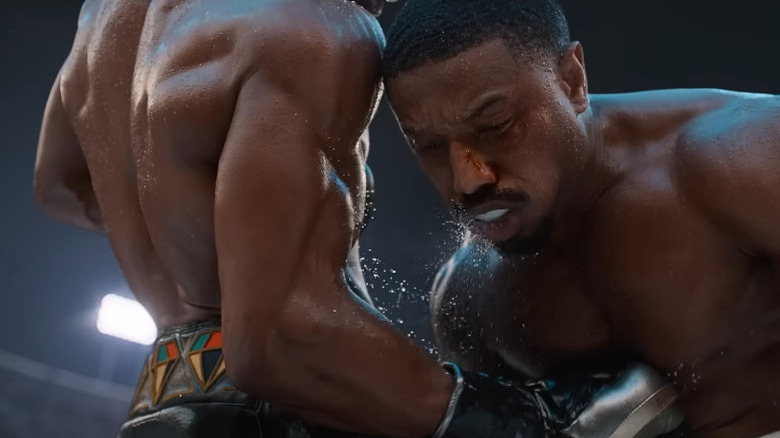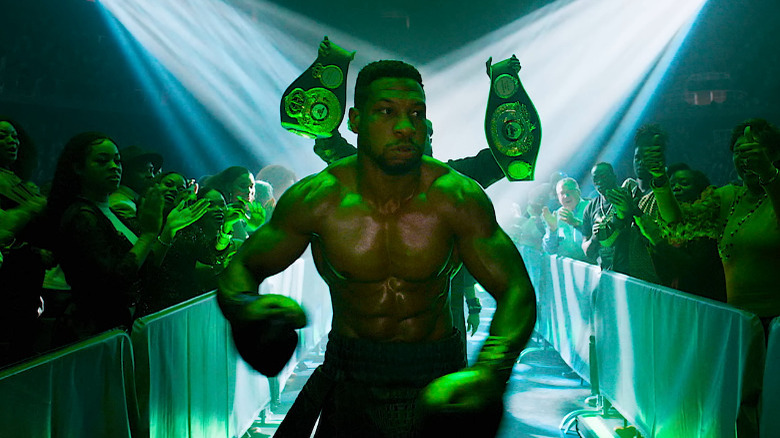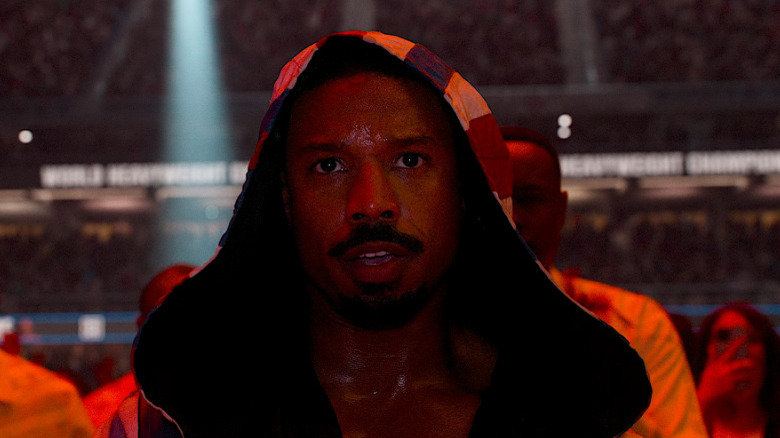Creed III Cinematographer On The Language Of Anime And The Greatest Fight Scene Ever [Exclusive Interview]
It's nothing short of astounding that the "Rocky" and "Creed" series is nearly 50 years old, and not only is it still going, but it's still going strong. The intergenerational saga of iconic underdog boxers — first Rocky Balboa, played by Sylvester Stallone, now Adonis Creed, played by Michael B. Jordan — continues to inspire new audiences, wow the most jaded critics, and make truckloads of money, and "Creed III" is no exception.
Michael B. Jordan has taken over the director's chair of the latest, powerful installment, and he's brought his "Creed II" and "Fahrenheit 451" cinematographer with him. Kramer Morgenthau's credits include acclaimed independent films like Jon Favreau's "Chef," blockbuster superhero movies like "Thor: The Dark World," and hit TV series like "Game of Thrones" and "Boardwalk Empire." We sat down with him to discuss keeping the legacy of the "Rocky" and "Creed" movies alive, bringing anime storytelling into a classic boxing series, how he used specific colors to tell each character's story, and what the best photographed fighting scene of all time is.
Note: This interview has been lightly edited for clarity and brevity.
'Nobody knows that character better than MBJ'
What was your relationship with the "Rocky" and "Creed" movies before you became a director of photography on the last two films?
I saw "Rocky I" in the theater when I was a kid, and I remember the day, I remember coming out of the theater. I remember the feeling I had when I saw that first film. I remember where I was, who I was with. I remember kind of punching my cousin with my fist and she was like telling me, "Stop, don't do that." I was playing around, and just so excited by that movie. It's such an uplifting story.
I think it's one of the great movies of American cinema. It tells this story of an underclass, of a subculture of Italian America, and a boxing rags to riches kind of story. It just hit the zeitgeist on the nose at the time. So I was a fan ever since. I'm not an uber fan, but I've always been a fan.
Awesome. So you've worked with Michael B. Jordan before, in both "Fahrenheit 451" and "Creed II." Can you tell me what your first meeting was like with him as a director and how he struck you in that particular role?
Yeah, I'd worked with Michael before, so it was a natural segue into our relationship as a director/cinematographer. We'd always been talking shots and talking about technique, and he's always had an interest. He's always been a student of cinematography and he's always been studying what directors are doing. He's been on set since he was 16 years old, so that was his film school.
He always was watching what [Ryan] Coogler was doing. I wasn't working with them, but I know that's ... and he was always watching what Steven Caple Jr. was doing. He was always paying attention to Denzel [Washington] when he worked with him as an actor/director. I think he learned and took away a lot from that. So it was very much a natural progression into our relationship, and we became friends right away on "Fahrenheit."
I think that had something to do with my getting hired on "Creed II," and then ultimately "Creed III." And it was such an honor to be asked to be at his side as his first time out as a director. I feel lucky to have been there. He just wanted to bring something, his own voice to the franchise. Nobody knows that character better than MBJ.
'Hopefully Creed III is a reflection of the time we're in'
You talk about how he's bringing his own voice to the franchise, but also he was inspired by Coogler, who you yourself didn't work with. What sort of conversations do you have about maintaining a visual continuity with all the films that came before? The style of the "Rocky" franchise has kind of evolved from a more naturalistic 1970s to a little bit more polished 1980s look, and Coogler and Caple and now Jordan have their own approach. Is the emphasis on that continuity, or is it always on trying to keep it fresh, since we're keeping the franchise going so long?
I think the emphasis is always a dance and a balance. Of course, you want to honor the legacy and the language of the "Rocky" films. It's a 50-year franchise, and each "Rocky" movie is a reflection of the decade that it was in, and hopefully "Creed III" is a reflection of the time we're in.
And the character has changed so much. He's a super successful boxer and kind of a cultural icon at this point, and it's kind of very much who MBJ is at this point. The MBJ I met on "Fahrenheit" and who he is today, he has changed so much. His life, he's become — "Black Panther" hadn't come out. "Fruitvale [Station]" had been out, but "Black Panther" hadn't been out, and he exploded on the world stage as a person, and is very much the same person. He's a very grounded person and a super down-to-earth guy. I think it has to do with how he was raised.
Would you say it's intentional or would you say it's subconscious that the "Rocky" movies tend to reflect the people who make them?
I think it's a bit of both. The "Rocky" movies are a reflection of the filmmakers, but also the reflection of the time period that the filmmakers are living in and the culture.
How does "Creed III" reflect the culture now, do you think?
There's so much. Just look at the clothes people are [wearing], the boxing gloves, the shorts. There was so much. Michael's such a dweeb about that stuff. He's really into all the graphic design, the way the gloves, the color, the material, the shorts, the way "Adonis" is written on there, the costume design. Lizz Wolf did such a great job as the costume designer.
And then the music, the hip hop, the stuff about police brutality going on post-George Floyd, and their experience as kids and how Dame goes away to jail. I think that even the original "Creed I" is about how he's been in a foster home as a kid, and he's been in juvenile detention, and that's a reflection of today. That's just one layer. There's so many different layers.
'A language completely different than cinematic language'
I think one layer, and this is something Michael B. Jordan has talked about in interviews, is he seems specifically influenced in some regards by anime, which probably wouldn't have been a major influence on John G. Avildsen in the '70s. Did he discuss with you that particular influence, that he wanted elements of the visual storytelling to be anime-inspired, and did he give you particular anime to watch, for example, for inspiration?
Yes to all of that. I think that anime is another reflection of the culture of today. I think Michael's generation in particular, there are a lot of people of his generation that are huge anime fans and grew up watching it. He just grew up being a fan of anime, and that was a language completely different than cinematic language, that he brought in. From the get-go, he was like, "I want to bring anime into the boxing," and it's a perfect fit because it's a very poetic language. It's a very subjective language. And so he definitely had me watch a lot of different anime. I can't really name any right now. [Laughs.]
Okay. So that part didn't stick with you, but what about the visual language on a practical level? Does it change your shot construction? Does it change the choreography as you capture it on camera? Is it noticeably different for you as a cinematographer from filming, for example, "Creed II?" And how so?
Yeah, using the language of anime completely changes everything. As a cinematographer, it's a whole different way of thinking. It's a very subjective language. It's a lot of using slow motion photography, using lenses that we had that had distortion elements to them. And it's just thinking about being inside the boxer mind. Some of it was like pre-visualization. The boxer sees a hole in the way that Dame is blocking, and then pre-visualizes that, and then he kind of threads the needle through the hole, and it's just a whole different way of thinking. And so it was a lot of fun to try and crack that egg.
'Green is envy and green is uneasiness'
One of the things I really liked about the way the film was photographed was the way you employ color. So much of the film is very dark, very moody. It's almost like a psychological thriller, but then when it's time for a boxing match, it's like the screen explodes with color. I'm thinking of Dame's entrance in particular, the smoke and everything. Can you tell me about that decision of when to employ color, and what that means to the film?
Yeah, I mean color was very carefully chosen, to use color as an expressive tool throughout the film. Dame's character is surrounded by green color, especially in the walkouts, but even in other parts of his world. And then Adonis, his character is surrounded by red. There's red all over his logos, there's red light in his walkouts, there's red everywhere. It's sort of this success and this kind of just ... I don't know, celebration of who he is.
Then when we shot the boxing, we shot it in IMAX and the aspect ratio changes to 1:90:1, a much taller screen and a different shape, and it's just more immersive and you're just kind of bathed in this color. And we use different colors schemes for the different matches. So South Africa is very warm. Dodger Stadium has blue, like Dodgers blue, and it's a lot of white light and the mat is white, and his uniform is white and it's really, really expressive.
You mentioned that Dame's predominant color scheme is green and Adonis' is red. Were those chosen for just their contrast or do you think green represents Dame in a particular way?
Yeah, I mean they're chosen for contrast, but they're also chosen for psychological reasons.
Can you tell me about that?
Yeah, we're not Vittorio Storaro with his psychological colors or anything like that, but we were kind of vibing on that. I mean, you could be very literal about it, that green is envy and green is uneasiness. He's kind of like this caged person that's just, all this talent and energy was taken away from him as a kid, and now he's just dying to get out there and live his life that was taken away from him. And he kind of vibes with Tessa's character who also is not able to live her full potential because of her hearing loss as a musician. And they have that scene in the record party where she's singing along but she can't actually be up on the stage herself, and he kind of clocks that, and they kind of have that connection there.
'If you're shooting a boxing movie, it's Raging Bull'
I guess we usually associate red with danger, but Adonis is a hero.
Yeah. That's true. That's a good...
Is there an irony there? Or do you think the way you employ it is different?
I think there was no intended irony there. It's red, it can also be ... color in different cultures, it can mean different things, but it was not intended to be ironic, that it's dangerous. More like it's just red. People are attracted to red. Like, hummingbirds are attracted to the color red.
As a cinematographer, from that point of view, what is the best photographed fight scene you've ever watched?
I think definitely up there is Jake LaMotta in "Raging Bull," is probably one of the pinnacles of all boxing films. You can't do a boxing scene without referencing it, even accidentally. That is up there in the pantheon of great boxing films. That's the one that is sort of, if you're shooting a gangster movie, it's "The Godfather," which we referenced in when I shot "Boardwalk Empire," and if you're shooting a boxing movie, it's "Raging Bull." And it's the same producer, actually, of "Raging Bull" and "Rocky I." Irwin Winkler.
"Creed III" is in theaters now.
